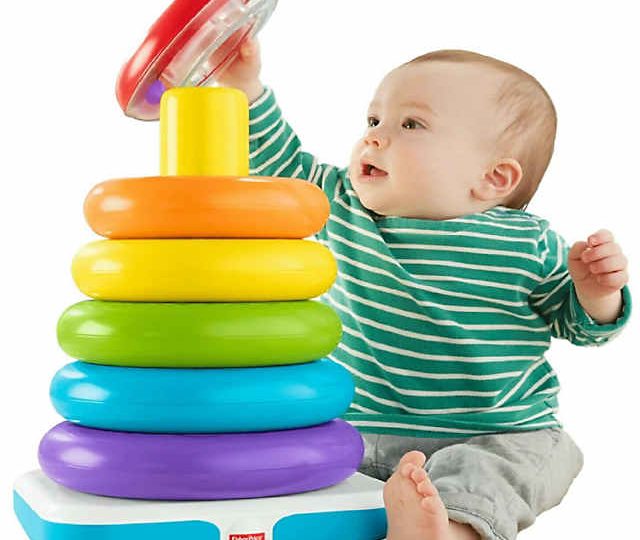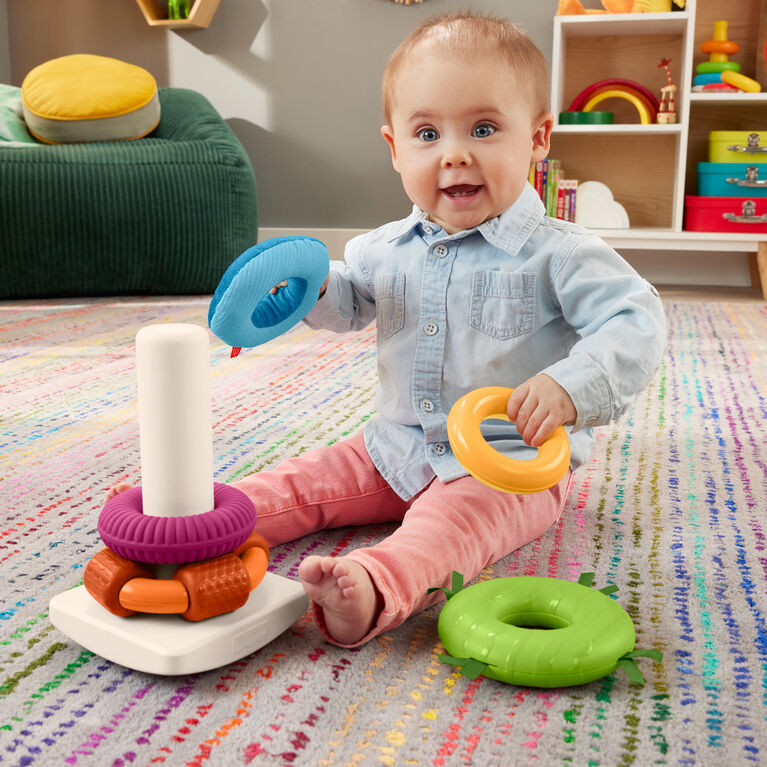
Creative Ways to Play with Baby Stacking Toys
The Developmental Benefits of Stacking Toys for Babies
Baby stacking toys offer more than just fun. They are key tools for developmental growth in infants and toddlers. Here’s how stacking toys can support your child’s development.
- Fine Motor Skills: Picking up, holding, and placing the pieces of a baby stacking toy help to hone fine motor skills. These are crucial for accomplishing everyday tasks like writing and buttoning clothes.
- Eye-Hand Coordination: Aligning the toys to stack them up improves eye-hand coordination. This skill is important for actions such as catching a ball or using a spoon.
- Cognitive Growth: Stacking toys encourage problem-solving and understanding of sizes and shapes. As babies learn to sort and stack, they begin to understand spatial relationships and logical order.
- Language Development: Playing with these toys can boost language skills. Parents can describe colors, shapes, and sizes, introducing new vocabulary during playtime.
- Sensory Stimulation: The varied textures and colors of stacking toys stimulate a baby’s sensory experiences. This helps to build neural pathways in the brain, essential for learning.
- Social and Emotional Development: Taking turns and sharing with siblings or parents during play teaches social skills and emotional understanding.
Baby stacking toys are simple yet powerful. With each stack and tumble, your baby is building a foundation for their future. Choose a baby stacking toy to support your child’s growth in these crucial areas.
Top Stacking Toys for Different Age Groups
Choosing the right baby stacking toy for your child is crucial. It must fit their developmental stage. Here’s a guide to the top stacking toys for different age groups.
0 to 6 Months Old
For the youngest infants, textures and sounds matter most. Soft, plush stacking rings with gentle rattling sounds are perfect. These toys are easy to grasp and safe for babies to explore with their mouths.
6 to 12 Months Old
At this stage, babies start sitting up and handling objects. Sturdy, colorful stacking cups are ideal. They are simple to stack and knock down, providing endless amusement.
1 to 2 Years Old
Toddlers love a challenge. Wooden stacking blocks with shapes that fit through matching holes encourage problem solving. These toys support learning about shapes and cause and effect.
2 to 3 Years Old
Around this age, children begin engaging in more complex play. Stacking toys that double as puzzles or building blocks are great. They promote creativity and fine motor skill refinement.
Choose toys that are safe, durable and grow with your child’s abilities. Avoid any with small parts that pose a choking hazard. Always supervise play to ensure your baby gets the most out of their stacking toy experience. Each stacking toy should provide a blend of fun and developmental support, no matter the baby’s age.
Innovative Games with Stacking Toys
Stacking toys are versatile playthings, and you can introduce innovative games to make the most of them. Here are creative ways to introduce new levels of fun and learning with your child’s stacking toys. Keep in mind that while babies may enjoy these activities, always supervise to ensure their safety.
- Stacking Race: Challenge older siblings or yourself to a stacking race. Use a timer to see who can stack and unstack the fastest. This game is thrilling and enhances speed and agility.
- Color Matching: Mix pieces from different sets and encourage your little one to match colors as they stack. It’s a playful way to teach colors and sorting skills.
- Height Challenge: Ask your child to build the tallest tower possible. This encourages strategic thinking and problem-solving as they work out how to keep the tower from toppling.
- Creative Storytelling: As you stack, create a story involving the stacking pieces as characters. This stimulates imagination and language skills, as well as provides entertainment.
- Counting Game: Integrate educational value by counting each piece added to the stack. It’s a simple way to introduce numbers and basic math during play.
- Balance and Weight: Place different objects on top of the stacked toys to teach balance and weight concepts. Kids find it fascinating to see what makes the stack fall and why.
By turning a baby stacking toy into a game, you make learning enjoyable. Remember to choose games that are appropriate for your child’s age and developmental stage. With these innovative ideas, you can help your baby or toddler to develop skills while they think they are just having fun.
Integrating Stacking Toys into Learning Activities
Using baby stacking toys in learning activities can boost your child’s intellectual growth beyond play. To maximize these benefits, try these hands-on, engaging exercises:
- Shape and Color Identification: While stacking, ask your child to name the shapes and colors. This integration strengthens recognition skills and vocabulary.
- Counting Practice: Encourage your child to count each piece as they stack. It’s a seamless way to work on numeracy and focus.
- Letter Recognition: If you have stacking blocks with letters, spell out simple words. This helps early literacy and letter familiarity.
- Memory Games: Hide a piece and ask your child to remember which is missing. This game sharpens memory and observational skills.
- Sequencing Skills: Use the stacking toys to create patterns. Challenge your child to continue the sequence. Such tasks improve logical thinking and sequencing abilities.
- Categorization: Group the toys by size, color, or type. Sorting activities like this foster categorization skills, critical in cognitive development.
Incorporate these playful learning exercises into regular playtime. By doing so, you turn a simple baby stacking toy into a multifaceted educational tool. Keep sessions short and engaging to maintain your child’s interest. Watch as your child learns and grows, one stack at a time.
Enhancing Motor Skills Through Stacking Toys
Stacking toys are not just another item in the toy box; they are vital tools for enhancing motor skills in babies and toddlers. Playing with a baby stacking toy can have a significant impact on the development of both gross and fine motor skills, which are essential for the physical development of a child. Here’s how stacking toys can contribute to motor skill enhancement:
- Grip Strength: Grasping and picking up stacking pieces strengthens the muscles in the fingers and hands, contributing to a firmer grip.
- Hand-Eye Coordination: Carefully placing one piece on top of another trains the eyes and hands to work together, a skill useful for writing and self-feeding.
- Dexterity: Transferring pieces from hand to hand and manipulating them to fit together improves dexterity and precision in movements.
- Balance and Control: Building a stable tower requires control and fine tuning of muscle movements, laying the groundwork for future activities like catching a ball or riding a bicycle.
- Spatial Awareness: Understanding how pieces fit together in space not only enhances cognitive development but also helps children gain an awareness of their body in relation to the space around them.
As parents, it’s important to present your child with age-appropriate stacking toys that challenge them without causing frustration. Encourage your baby to play regularly with stacking toys to promote their motor skill development effectively. Carefully selected baby stacking toy can provide the support needed for your child’s motor skill mastery, ensuring they have the dexterity and coordination needed for later life skills.
Tips for Choosing Safe and Appropriate Stacking Toys
When picking out a baby stacking toy, safety and suitability are top priorities. Follow these tips:
- Non-toxic Materials: Choose toys made of non-toxic materials to keep your baby safe.
- No Small Parts: Avoid toys with small pieces that could be choking hazards for young children.
- Durable Construction: Select toys that can withstand dropping and biting without breaking.
- Age-Appropriate Design: Look for toys designed for your child’s age to match their developmental needs.
- Easy to Clean: Pick stacking toys that are simple to wipe down or wash to maintain hygiene.
- Bright, Engaging Colors: Opt for toys with vivid colors to captivate your baby’s attention and stimulate vision.
- Sensory Features: Some toys come with features like rattles or different textures to enhance sensory play.
- Educational Value: Consider if the toy can aid in learning colors, numbers, or shapes as your child grows.
By keeping these considerations in mind, you’ll find the perfect stacking toys that are both safe for your baby and beneficial for their development.
Maintaining and Cleaning Stacking Toys for Longevity
To ensure the durability and safety of your child’s baby stacking toy, regular maintenance and cleaning are essential. Here’s how to take care of these toys so they can last through years of play.
- Regular Checks: Inspect the toys frequently for any signs of wear or damage. Look for cracks, splinters, or peeling paint that could harm your child.
- Gentle Cleaning: Use a mild soap with warm water to wipe down the toys. Be gentle to avoid damaging the surface or colors.
- Avoid Harsh Chemicals: Steer clear of strong cleaning agents that might leave harmful residues or deteriorate the toy’s material.
- Air Dry: After cleaning, let the stacking toys air dry completely before giving them back to your child. This helps to prevent mold growth.
- Proper Storage: Store the toys in a dry, cool place to avoid exposure to heat and humidity that can warp or damage the toys.
- Rotate Toys: Regularly rotate your child’s toys. This not only keeps them intrigued with ‘new’ toys but also reduces wear and tear on any one toy.
By following these simple steps, your baby’s stacking toy can remain a safe, fun, and lasting addition to their collection. It’s worth noting that the way you care for a toy can be just as important as the initial selection for ensuring the ongoing safety and enjoyment of your child.
Creative DIY Stacking Toy Ideas
Creativity needn’t be complex or costly, especially when it comes to playtime. You can craft engaging and safe baby stacking toys right at home with simple materials. Not only will these DIY ideas save you money, they’ll also give a personal touch to your baby’s playtime. Here’s how to create your own baby stacking toy with items you likely have around the house:
- Recycled Cardboard Rings: Slice circles from cardboard boxes. Use tubes from paper towels or toilet paper rolls to create a tower base for stacking.
- Homemade Wooden Blocks: Sand down wooden scraps into various shapes. Paint them with child-safe, non-toxic paint for a colorful stacking game.
- Fabric Stacking Pyramid: Sew fabric into different size squares. Fill them with batting to make soft, stackable squares that can form a pyramid.
- Plastic Bottle Caps Tower: Collect caps from plastic bottles. Clean them and stack to form towers. Bonus points for using caps of different sizes and colors.
- Sponge Towers: Cut ordinary kitchen sponges into shapes. These make for soft, durable, and easy-to-grip stacking pieces.
- Velcro Stick Cups: Attach Velcro strips to the edges of paper or plastic cups. They’ll stick together, creating a fun and unique stacking experience.
These DIY baby stacking toy ideas are not only enjoyable to make but also help develop your child’s motor skills, coordination, and creativity. Always ensure the safety of materials used and supervise your child during playtime. With a little imagination, your homemade stacking toys can provide hours of fun and developmental benefits.


